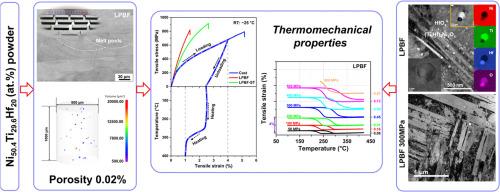NiTiHf high-temperature shape memory alloy fabricated via laser powder bed fusion showing fully recoverable actuation under tensile stress
IF 9.3
1区 材料科学
Q1 MATERIALS SCIENCE, MULTIDISCIPLINARY
引用次数: 0
Abstract
NiTiHf high-temperature shape memory alloys (HTSMAs) fabricated via laser powder bed fusion (LPBF) suffer from poor tensile strength preventing their successful use in engineering applications. We managed to fabricate NiTiHf HTSMA showing tensile actuation under stresses up to 500 MPa in the temperature range 250–350 °C. A tensile strength of 821 MPa, an actuation strain 2.34 % under 300 MPa tensile stress with negligible irrecoverable plastic strain, and fracture upon cooling under 600 MPa tensile stress are the best values reported so far for LPBF-fabricated NiTiHf HTSMAs in the literature. The enhanced tensile strength reaching half of the strength of the conventional cast and thermomechanically processed NiTiHf HTSMAs was attributed to the lack of micropores (porosity 0.02 %). The tensile actuation performance is claimed to be facilitated by the strengthening effect from homogeneously distributed oxide nanoparticles introduced naturally by the LPBF fabrication. The oxide nanoparticles decrease the size of domains of (001) compound twinned martensite created by the forward martensitic transformation upon cooling under stress, which reduces actuation strain but also suppresses dislocation slip in martensite. This dimensional strengthening mechanism lowers actuation strain but increases cyclic stability of the actuation response of the LPBF NiTiHf HTSMA.


采用激光粉末床熔合法制备的NiTiHf高温形状记忆合金在拉伸应力下表现出完全可恢复的致动特性
采用激光粉末床熔合(LPBF)制备的NiTiHf高温形状记忆合金(htsma)抗拉强度较差,阻碍了其在工程上的成功应用。我们成功地制造了NiTiHf HTSMA,在250-350°C的温度范围内,在高达500 MPa的应力下显示拉伸驱动。抗拉强度为821 MPa, 300 MPa拉应力下的驱动应变为2.34%,不可恢复的塑性应变可以忽略不计,600 MPa拉应力下的冷却断裂是迄今为止文献中报道的lpbf制备的NiTiHf htsma的最佳值。由于没有微孔(孔隙率为0.02%),合金的抗拉强度达到了传统铸造和热处理NiTiHf htsma的一半。拉伸驱动性能被认为是由LPBF制造过程中自然引入的均匀分布的氧化纳米颗粒的强化效应所促进的。氧化纳米颗粒减小了(001)复合孪晶马氏体在应力作用下冷却产生的正向马氏体相变,从而减小了驱动应变,抑制了马氏体中的位错滑移。这种尺寸强化机制降低了驱动应变,但增加了LPBF NiTiHf HTSMA驱动响应的循环稳定性。
本文章由计算机程序翻译,如有差异,请以英文原文为准。
求助全文
约1分钟内获得全文
求助全文
来源期刊

Acta Materialia
工程技术-材料科学:综合
CiteScore
16.10
自引率
8.50%
发文量
801
审稿时长
53 days
期刊介绍:
Acta Materialia serves as a platform for publishing full-length, original papers and commissioned overviews that contribute to a profound understanding of the correlation between the processing, structure, and properties of inorganic materials. The journal seeks papers with high impact potential or those that significantly propel the field forward. The scope includes the atomic and molecular arrangements, chemical and electronic structures, and microstructure of materials, focusing on their mechanical or functional behavior across all length scales, including nanostructures.
 求助内容:
求助内容: 应助结果提醒方式:
应助结果提醒方式:


